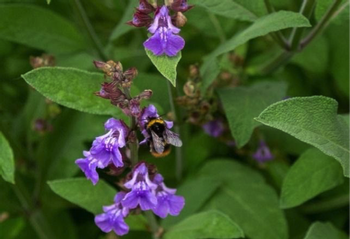Sage
-
Scientific NameSalvia officinalis
-
General InformationEasy, prolific, drought-tolerant, perennial grows one to two feet tall. Has rough-textured, green-gray leaves and lavender, white, or blue flowers in summer. Leaves and flowers are edible. Hundreds of varieties. Attracts hummingbirds, bees, and butterflies. Used for centuries for cooking and medicine. Native to Mediterranean and North Africa.
 Photo: Pixabay
Photo: Pixabay -
When to Plant
Sage can be grown from seed in late spring or early summer, propagated from root cuttings taken in the summer, or planted as starts. Seeds mature slowly, which is why starts are more popular. Soil should be between 60 and 70 degrees for best results.
-
Planting
Plant 18 to 30 inches apart in full sun. Does best with afternoon shade in the hottest locations. Tolerates some frost. Needs good air circulation. Look under the leaves for new seedlings that may have sprouted, as these can be transplanted. Grows one to two feet tall, has green-gray leaves with a rough texture, and blooms in summer with lavender, white, or blue flowers. Both the leaves and flowers are edible. There are hundreds of varieties of sage.
-
Soil Requirements
Sage needs well-drained soil with an ideal pH between 6.5 and 7.
-
Water Requirements
Do not over water. Sage is drought tolerant and susceptible to root rot. Wait until the soil is dry to give it a thorough watering. Sage does not do well in humid, hot weather.
-
Fertilizing
Does not need fertilizer. Simply add a thin layer of compost.
-
Pollination
Sage attracts bees, butterflies and hummingbirds, and has a unique pollination mechanism that utilizes levers.
-
Harvesting
Harvest the leaves lightly the first year. After that, harvest anytime for fresh leaves, but harvest before flowering for drying. For the best concentration of oils, take the leaves in the morning after the dew has dried. Don’t harvest more than half of the plant at any one time.
-
Storage
Usually cooked, not eaten raw. When fresh, will keep refrigerated four to five days wrapped in paper towel and put in plastic bag or, if covered in oil, three weeks. Easy to freeze. Good for a year packed loosely in a freezer bag. Most popular in dried form, which includes whole leaf, rubbed, and ground. Store in an airtight container.
-
Good Varieties for Marin
Sage is well-suited to our climate, so pick the color and flavor preferred.
‘Tricolor’ has purple, red and white variegated leaves.
'Berggarten’ has thick velvety gray leaves.
‘Dwarf’ is great for small gardens.
‘Purpurescens’ has purple leaves.
‘Golden Delicious’ has chartreuse leaves and does best in partial shade.
-
Helpful Tips
Remove the woody growth every spring to encourage tender shoots. When they get too woody, replace them, typically around three to four years.
-
Common Problems
Sage can have problems with mildew, so thin stalks to keep good air circulation. Does not like heavy frost.
-
Pests- Diseases & More
Some possible problems include slugs, spider mites, spittle bugs, root rot and wilt.
http://ipm.ucanr.edu/PMG/GARDEN/PLANTS/salvia.html

